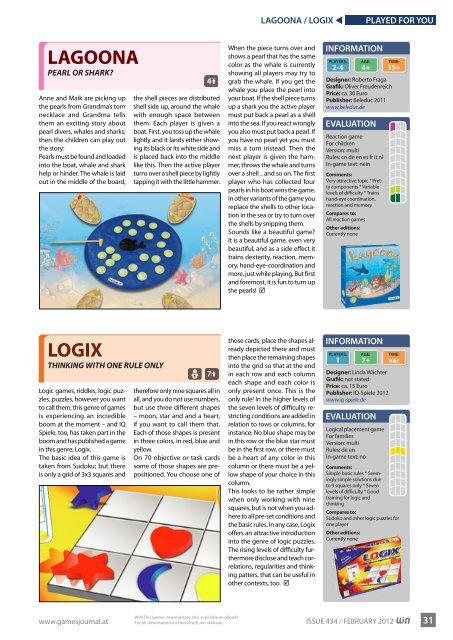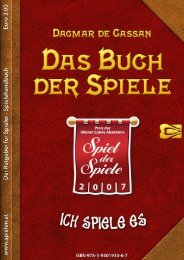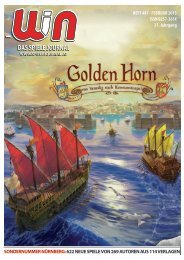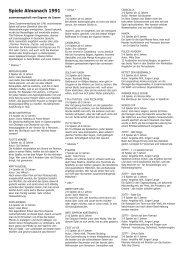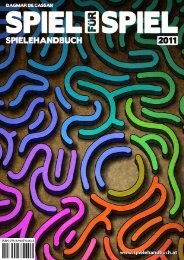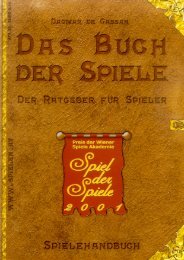THE GAMES JOURNAL - Österreichisches Spiele Museum
THE GAMES JOURNAL - Österreichisches Spiele Museum
THE GAMES JOURNAL - Österreichisches Spiele Museum
Create successful ePaper yourself
Turn your PDF publications into a flip-book with our unique Google optimized e-Paper software.
LAGOONA<br />
PEARL OR SHARK?<br />
Anne and Maik are picking up<br />
the pearls from Grandma’s torn<br />
necklace and Grandma tells<br />
them an exciting story about<br />
pearl divers, whales and sharks;<br />
then the children can play out<br />
the story:<br />
Pearls must be found and loaded<br />
into the boat, whale and shark<br />
help or hinder. The whale is laid<br />
out in the middle of the board,<br />
LOGIX<br />
THINKING WITH ONE RULE ONLY<br />
Logic games, riddles, logic puzzles,<br />
puzzles, however you want<br />
to call them, this genre of games<br />
is experiencing an incredible<br />
boom at the moment – and IQ<br />
<strong>Spiele</strong>, too, has taken part in the<br />
boom and has published a game<br />
in this genre, Logix.<br />
The basic idea of this game is<br />
taken from Sudoku; but there<br />
is only a grid of 3x3 squares and<br />
4�<br />
the shell pieces are distributed<br />
shell side up, around the whale<br />
with enough space between<br />
them. Each player is given a<br />
boat. First, you toss up the whale<br />
lightly and it lands either showing<br />
its black or its white side and<br />
is placed back into the middle<br />
like this. Then the active player<br />
turns over a shell piece by lightly<br />
tapping it with the little hammer.<br />
7�<br />
therefore only nine squares all in<br />
all, and you do not use numbers,<br />
but use three di�erent shapes<br />
– moon, star and and a heart,<br />
if you want to call them that.<br />
Each of those shapes is present<br />
in three colors, in red, blue and<br />
yellow.<br />
On 70 objective or task cards<br />
some of those shapes are prepositioned.<br />
You choose one of<br />
LAGOONA / LOGIX t<br />
When the piece turns over and<br />
shows a pearl that has the same<br />
color as the whale is currently<br />
showing all players may try to<br />
grab the whale. If you get the<br />
whale you place the pearl into<br />
your boat. If the shell piece turns<br />
up a shark you the active player<br />
must put back a pearl as a shell<br />
into the sea. If you react wrongly<br />
you also must put back a pearl. If<br />
you have no pearl yet you must<br />
miss a turn instead. Then the<br />
next player is given the hammer,<br />
throws the whale and turns<br />
over a shell .. and so on. The �rst<br />
player who has collected four<br />
pearls in his boat wins the game.<br />
In other variants of the game you<br />
replace the shells to other location<br />
in the sea or try to turn over<br />
the shells by snipping them.<br />
Sounds like a beautiful game?<br />
It is a beautiful game, even very<br />
beautiful, and as a side e�ect it<br />
trains dexterity, reaction, memory,<br />
hand-eye-coordination and<br />
more, just while playing. But �rst<br />
and foremost, it is fun to turn up<br />
the pearls! �<br />
those cards, place the shapes already<br />
depicted there and must<br />
then place the remaining shapes<br />
into the grid so that at the end<br />
in each row and each column<br />
each shape and each color is<br />
only present once. This is the<br />
only rule! In the higher levels of<br />
the seven levels of di�culty restricting<br />
conditions are added in<br />
relation to rows or columns, for<br />
instance: No blue shape may be<br />
in this row or the blue star must<br />
be in the �rst row, or there must<br />
be a heart of any color in this<br />
column or there must be a yellow<br />
shape of your choice in this<br />
column.<br />
This looks to be rather simple<br />
when only working with nine<br />
squares, but is not when you adhere<br />
to all pre-set conditions and<br />
the basic rules. In any case, Logix<br />
o�ers an attractive introduction<br />
into the genre of logic puzzles.<br />
The rising levels of di�culty furthermore<br />
disclose and teach correlations,<br />
regularities and thinking<br />
patters, that can be useful in<br />
other contexts, too. �<br />
INFORMATION<br />
Designer: Roberto Fraga<br />
Gra�k: Oliver Freudenreich<br />
Price: ca. 30 Euro<br />
Publisher: Beleduc 2011<br />
www.beleduc.de<br />
EVALUATION<br />
Reaction game<br />
For children<br />
Version: multi<br />
Rules: cn de en es fr it nl<br />
In-game text: nein<br />
Comments:<br />
Very attractive topic * Pretty<br />
components * Variable<br />
levels of di�culty * Trains<br />
hand-eye coordination,<br />
reaction and memory<br />
Compares to:<br />
All reaction games<br />
Other editions:<br />
Currently none<br />
PLAYED FOR YOU<br />
WIN The Games Journal now also available as eBook!<br />
www.gamesjournal.at For all information on that check our website.<br />
ISSUE 434 / FEBRUARY 2012 31<br />
PLAYERS:<br />
2-4<br />
AGE:<br />
4+<br />
INFORMATION<br />
PLAYERS:<br />
1<br />
AGE:<br />
7+<br />
Designer: Linda Wächter<br />
Gra�k: not stated<br />
Price: ca. 15 Euro<br />
Publisher: IQ-<strong>Spiele</strong> 2012<br />
www.iq-spiele.de<br />
EVALUATION<br />
Logical placement game<br />
For families<br />
Version: multi<br />
Rules: de en<br />
In-game text: no<br />
TIME:<br />
15+<br />
TIME:<br />
var<br />
Comments:<br />
Simple basic rules * Seemingly<br />
simple solutions due<br />
to 9 squares only * Seven<br />
levels of di�culty * Good<br />
training for logic and<br />
thinking<br />
Compares to:<br />
Sudoko and other logic puzzles for<br />
one player<br />
Other editions:<br />
Currently none none


